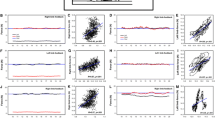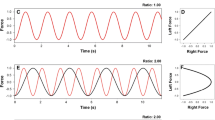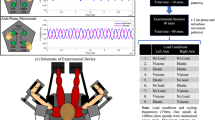Abstract
The experiment was designed to determine participants’ ability to coordinate a bimanual multifrequency pattern of isometric forces using homologous or non-homologous muscles. Lissajous feedback was provided to reduce perceptual and attentional constraints. The primary purpose was to determine whether the activation of homologous and non-homologous muscles resulted in different patterns of distortions in the left limb forces that are related to the forces produced by the right limb. The task was to rhythmically produce a 1:2 pattern of isometric forces by exerting isometric forces on the left side force transducer with the left arm that was coordinated with the pattern of isometric forces produced on the right side force transducer with the right arm. The results indicated that participants were able to ‘tune-in’ a 1:2 coordination patterns using homologous (triceps muscles of the left and right limbs) and using non-homologous muscles (biceps left limb and triceps right limb) when provided Lissajous feedback. However, distinct but consistent and identifiable distortions in the left limb force traces were observed for both the homologous and non-homologous tasks. For the homologous task, the interference occurred in the left limb when the right limb was initiating and releasing force. For the non-homologous task, the interference in the left limb force occurred only when the right limb was releasing force. In both conditions, the interference appeared to continue from the point of force initiation and/or release to peak force velocity. The overall results are consistent with the notion that neural crosstalk manifests differently during the coordination of the limbs depending upon whether homologous or non-homologous muscles are activated.






Similar content being viewed by others
References
Aramaki Y, Osu R, Sadato N (2010) Resource-demanding versus cost-effective bimanual interaction in the brain. Exp Brain Res 203:407–418
Armatas CA, Summers JJ (2001) The influence of task characteristics on the intermanual asymmetry of motor overflow. J Clin Exp Neuropsychol 23:557–567
Baechle TR, Earle RW (2008) Essentials of strength training and conditioning, 3rd edn. Human Kinetics, Champaign
Barral J, Debû B, Rival C (2006) Developmental changes in unimanual and bimanual aiming movements. Dev Neuropsychol 29:415–429
Barral J, De Pretto M, Debû B, Hauert CA (2010) Activation and inhibition of bimanual movements in school-aged children. Hum Physiol 36:47–57
Bingham GP, Schmidt RC, Zaal FT (1999) Visual perception of the relative phasing of human limb movements. Percept Psychophys 61:246–258
Boyles J, Panzer S, Shea CH (2012) Increasingly complex bimanual multi-frequency coordination patterns are equally easy to perform with on-line relative velocity feedback. Exp Brain Res 216:515–525
Buchanan JJ, Park JH, Shea CH (2006) Target width scaling in a repetitive aiming task: switching between cyclical and discrete units of action. Exp Brain Res 175:710–725
Byblow WD, Goodman D (1994) Performance asymmetries in multifrequency coordination. Hum Mov Sci 13:147–174
Byblow WD, Bysouth-Young D, Summers JJ, Carson RG (1998) Performance asymmetries and coupling dynamics in the acquisition of multifrequency bimanual coordination. Psychol Res 61:56–70
Cardoso de Oliveira S (2002) The neuronal basis of bimanual coordination: recent neurophysiological evidence and functional models. Acta Psychol 110:139–159
Carson RG (1995) The dynamics of isometric bimanual coordination. Exp Brain Res 105:465–476
Carson RG, Riek CJ, Smethurst JF, Lison Parraga JF, Byblow WD (2000) Neuromuscular-skeletal constraints upon the dynamics of unimanual and bimanual coordination. Exp Brain Res 131:196–214
Cattaert D, Semjen A, Summers JJ (1999) Simulating a neural cross-talk model for between-hand interference during bimanual circle drawing. Biol Cybern 81:343–358
Cincotta M, Giovannelli F, Borgheresi A, Balestrieri F, Vanni P, Ragazzoni A, Zaccara G, Ziemann U (2006) Surface electromyography shows increased mirroring in Parkinson’s disease patients without overt mirror movements. Mov Disord 21:1461–1465
Cohen L (1971) Synchronous bimanual movements performed by homologous and non-homologous muscles. Percept Mot Skill 32:639–644
Diedrichsen J, Hazeltine E, Nurss WK, Ivry RB (2003) The role of the corpus callosum in the coupling of bimanual isometric force pulses. J Neurophysiol 4:2409–2418
Franz EA, Eliassen JC, Ivry RB, Gazzaniga MS (1996) Dissociation of spatial and temporal coupling in the bimanual movements of callosotomy patients. Psychol Sci 7:306–310
Gordon Y, Ghez C (1984) EMG patterns in antagonist muscles during isometric contraction in man: relations to response dynamics. Exp Brain Res 55:167–171
Guiard Y (1993) On Fitts’s and Hooke’s laws: simple harmonic movement in upper-limb cyclical aiming. Acta Psychol 82:139–159
Guiard Y (1997) Fitts' law in the discrete vs cyclical paradigm. Hum Mov Sci 16:97–131
Haken H, Kelso JA, Bunz H (1985) A theoretical model of phase transitions in human hand movements. Biol Cybern 51:347–356
Heuer H, Kleinsorge T, Spijkers W, Steglich W (2001) Static and phasic cross-talk effects in discrete bimanual reversal movements. J Mot Behav 33:67–85
Heuer H, Spijkers W, Steglich C, Kleinsorge T (2002) Parametric coupling and generalized decoupling revealed by concurrent and successive isometric contractions of distal muscles. Acta Psychol 136:205–242
Houweling S, Beek PJ, Daffertshofer A (2010) Spectral changes of interhemispheric crosstalk during movement instabilities. Cereb Cortex 20:2605–2613
Hu X, Loncharich M, Newell KM (2011) Visual information interacts with neuromuscular factors in the coordination of bimanual isometric force. Exp Brain Res 209:129–138
Kagerer FA, Summers JJ, Semjen A (2003) Instabilities during antiphase bimanual movements: are ipsilateral pathways involved? Exp Brain Res 151:489–500
Kato K, Muraoka T, Higuchi T, Mizuguchi N, Kanosue K (2014) Interaction between simultaneous contraction and relaxation in different limbs. Exp Brain Res 232:181–189
Kelso JAS (1984) Phase-transitions and critical-behavior in human bimanual coordination. Am J Physiol Soc 246:1000–1004
Kelso JAS (1994) The informational character of self-organized coordination dynamics. Hum Mov Sci 13:393–413
Kelso JAS, Scholz JP, Schoner G (1986) Nonequilibrium phase-transitions in coordinated biological motion—critical fluctuations. Phys Lett A 118:279–284
Kennedy DM, Boyle JB, Shea CH (2013a) The role of auditory and visual models in the production of bimanual tapping patterns. Exp Brain Res 224:507–518
Kennedy DM, Boyle JB, Wang C, Shea CH (2013b) Bimanual force production: cooperation and interference. J Sport Exerc Psychol 35:S33
Kennedy DM, Wang C, Shea CH (2013c) Reacting while moving: influence of right limb movement on left limb reaction. Exp Brain Res 230:143–152
Kennerley SW, Diedrichsen J, Hazeltine E, Semjen A, Ivry RB (2002) Callosotomy patients exhibit temporal uncoupling during continuous bimanual movements. Nat Neurosci 5:376–381
Kirk RE (1968) Experimental design procedures for behavior sciences. Wadsworth, Belmont
Kovacs AJ, Shea CH (2011) The learning of 90 degrees continuous relative phase with and without Lissajous feedback: external and internally generated bimanual coordination. Acta Psychol 136:311–320
Kovacs AJ, Buchanan JJ, Shea CH (2009) Bimanual 1:1 with 90 degrees continuous relative phase: difficult or easy! Exp Brain Res 193:129–136
Kovacs AJ, Buchanan JJ, Shea CH (2010a) Impossible is nothing: 5:3 and 4:3 multi-frequency bimanual coordination. Exp Brain Res 201:249–259
Kovacs AJ, Buchanan JJ, Shea CH (2010b) Perceptual and attentional influences on continuous 2:1 and 3:2 multi-frequency bimanual coordination. J Exp Psychol Hum Percept Perform 36:936–954
Kugler PN, Turvey M (1987) Information, natural law, and the self-assembly of rhythmic movement. Lawrence Erlbaum, Mahwah
Li Y, Levin O, Carson RG, Swinnen SP (2004) Bimanual coordination: constraints imposed by the relative timing of homologous muscle activation. Exp Brain Res 217:1–5
Marteniuk RG, Mackenzie CL, Baba DM (1984) Bimanual movement control—information-processing and interaction effects. Q J Exp Psychol 36:335–365
Mechsner F, Knoblich G (2004) Do muscles matter for coordinated action? J Exp Psychol Hum Percept Perform 30:490–503
Mechsner F, Kerzel D, Knoblich G, Prinz W (2001) Perceptual basis of bimanual coordination. Nature 414:69–73
Peper CE, Beek, PJ, van Wieringen PCW (1995a) Coupling strength in tapping a 2/3 polyrhythm. Hum Mov Sci 14:217–245
Peper CE, Beek PJ, van Wieringen PC (1995b) Frequency-induced phase transitions in bimanual tapping. Biol Cybern 73:301–309
Peper CE, Beek PJ, van Wieringen PC (1995c) Multifrequency coordination in bimanual tapping: asymmetric coupling and signs of supercriticality. J Exp Psychol Hum Percept Perform 21:1117–1138
Puttemans V, Wenderoth N, Swinnen SP (2005) Changes in brain activation during the acquisition of a multifrequency bimanual coordination task: from the cognitive stage to advanced levels of automaticity. J Neurosci 25:4270–4278
Ridderikhoff A, Peper CL, Beek PJ (2005) Unraveling interlimb interactions underlying bimanual coordination. J Neurophysiol 94:3112–3125
Riek S, Carson RG, Byblow WD (1992) Spatial and muscular dependencies in bimanual coordination. J Hum Mov Stud 23:251–265
Salesse R, Oullier O, Temprado JJ (2005) Plane of motion mediates the coalition of constraints in rhythmic bimanual coordination. J Mot Behav 37:454–464
Salter JE, Wishart LR, Lee TD, Simon D (2004) Perceptual and motoric contributions to bimanual coordination. Neurosci Lett 363:102–107
Schöner G, Kelso JAS (1988) Dynamic pattern generation in behavioral and neural systems. Science 239:1513–1520
Semjen A, Summers JJ, Cattaert D (1995) Hand coordination in bimanual circle drawing. J Exp Psychol Hum Percept Perform 21:1139–1157
Sherwood DE (1994) Hand preference, practice order, and spatial assimilations in rapid bimanual movements. J Mot Behav 26:123–134
Spijkers W, Heuer H (1995) Structural constraints on the performance of symmetrical bimanual movements with different amplitudes. Q J Exp Psychol 48:716–740
Steglich C, Heuer H, Spijkers W, Kleinsorge T (1999) Bimanual coupling during the specification of isometric forces. Exp Brain Res 129:302–316
Summers JJ, Davis AS, Byblow WD (2002) The acquisition of bimanual coordination is mediated by anisotropic coupling between the hands. Hum Mov Sci 2:699–721
Summers JJ, Ford SK, Todd JA (1993a) Practice effects on the coordination of the 2 hands in a bimanual tapping task. Hum Mov Sci 12:111–133
Summers JJ, Todd JA, Kim YH (1993b) The influence of perceptual and motor factors on bimanual coordination in a polyrhythmic tapping task. Psychol Res 55:107–115
Swinnen SP (2002) Intermanual coordination: from behavioural principles to neural–network interactions. Nature Rev 3:350–361
Swinnen SP, Dounskaia N, Walter CB, Serrien DJ (1997) Preferred and induced coordination modes during the acquisition of bimanual movements with a 2:1 frequency ratio. J Exp Psychol Hum Percept Perform 23:1087–1110
Swinnen SP, Dounskaia N, Levin O, Duysens J (2001) Constraints during bimanual coordination: the role of direction in relation to amplitude and force requirements. Behav Brain Res 123:201–218
Swinnen SP, Dounskaia N, Duysens J (2002) Patterns of bimanual interference reveal movement encoding within a radial egocentric reference frame. J Cogn Neurosci 14:463–471
Temprado JJ, Swinnen SP, Carson RG, Tourment A, Laurent M (2003) Interaction of directional, neuromuscular and egocentric constraints on the stability of preferred bimanual coordination patterns. Hum Mov Sci 22:339–363
Todor JI, Lazarus JA (1986) Exertion level and the intensity of associated movements. Dev Med Child Neurol 28:205–212
Treffner PJ, Turvey MT (1993) Resonance constraints on rhythmic movement. J Exp Psychol Hum Percept Perform 19:1221–1237
Yamanishi J, Kawato M, Suzuki R (1980) Two coupled oscillators as a model for the coordinated finger tapping by both hands. Biol Cybern 37:219–225
Zanone PG, Kelso JAS (1992) The evolution of behavioral attractors with learning: nonequilibrium phase transitions. J Exp Psychol Hum Percept Perform 18:403–421
Acknowledgments
This work was supported by grants from the College of Education and Human Development and the Huffines Institute at Texas A&M University to D.M. Kennedy.
Author information
Authors and Affiliations
Corresponding author
Rights and permissions
About this article
Cite this article
Kennedy, D.M., Boyle, J.B., Rhee, J. et al. Rhythmical bimanual force production: homologous and non-homologous muscles. Exp Brain Res 233, 181–195 (2015). https://doi.org/10.1007/s00221-014-4102-y
Received:
Accepted:
Published:
Issue Date:
DOI: https://doi.org/10.1007/s00221-014-4102-y




